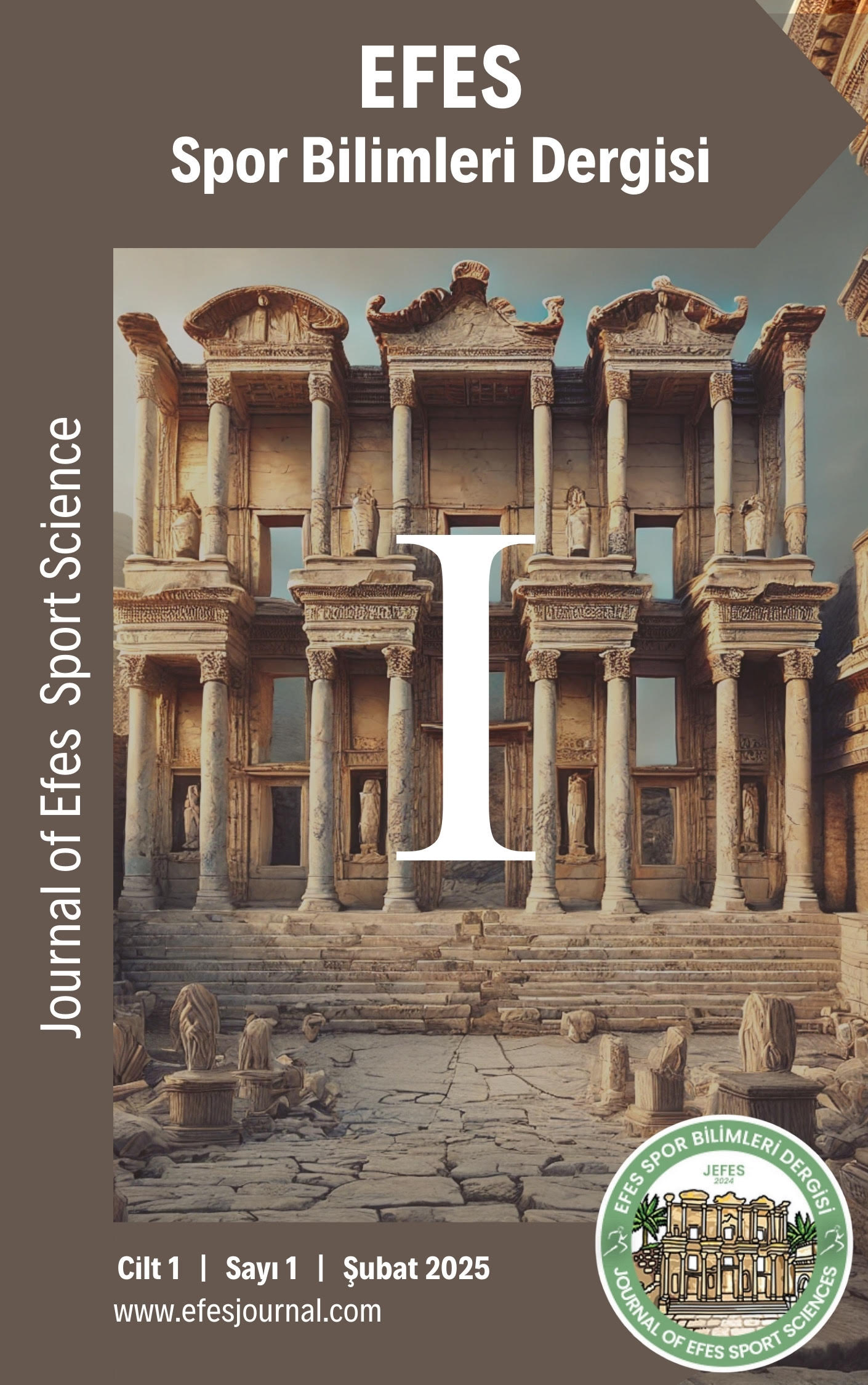THE EFFECT OF YOGA AND DANCE ON SPIRITUAL DEEPENING
YOGA VE DANSIN RUHSAL DERİNLEŞME ÜZERİNE ETKİSİ
DOI:
https://doi.org/10.5281/zenodo.15038037Abstract
This study aims to examine the contributions of yoga and dance to spiritual depth. By investigating the effects of these two practices on individuals' physical and mental health in daily life, it seeks to explore their roles in achieving inner balance and personal development. Both yoga and dance, while effective individually in enhancing physical flexibility and mental calmness, become even more impactful when combined. Yoga strengthens the connection between mind and body by increasing flexibility, while dance offers emotional expression and freedom. The study highlights how the combination of yoga and dance is highly effective in developing personal awareness, establishing emotional balance, and achieving inner peace. The integration of these practices is significant not only for physical health but also for spiritual depth and well-being. Additionally, when supported by mindfulness, these practices enhance individuals' ability to cope with stress and strengthen their mental health. As a result, it is concluded that yoga and dance are powerful tools that assist individuals in finding inner balance, improving emotional and mental health, and coping with stress more effectively.
References
Akarsu, R. H., & Rathfsch, G. (2018). Sihirli Bir Yol: Gebelik Yogası A Magic Way: Pregnancy Yoga. Smyrna Tıp Dergisi, 57, 61.
Alkan, E., & Özçoban, F. A. (2017). Yoganın gebelik, doğum ve doğum sonuçları üzerine etkisi effect of yoga on pregnancy, delivery and birth outcomes. Smyrna Tıp Dergisi (3), 64-71.
Altan Sarıkaya, N., Ayhan, H., & Sukut, Ö. (2017). Use and effect of dance and movement therapy in different groups.
Betül, S. (2011). Huzura Sekiz Adım Yama-Niyama-Asana. Doğal Yollarla İyileşme Yöntemleri ve Bilinçli Yaşam Derneği İktisadi İşletmesi Yayınları 1. Basım Şubat 2011, Ankara. ISBN: 978-605-88223-2-0.
Cahn, B. R., & Polich, J. (2006). Meditation states and traits: EEG, ERP, and neuroimaging studies. Psychological Bulletin, 132(2), 180.
Desikachar, T. K. V. (1995). The Heart of Yoga: Developing a Personal Practice. Inner Traditions.
Duman, Ö., & Koca, C. (2020). Modern Yoganın Analizi: Cinsiyetlendirilmiş Bir Sosyal Alan. Fe Dergi, 12(2), 59-73. https://doi.org/10.46655/federgi.842925
Efe, F., & Keyvan, A. (2021). Kaygı, depresyon ve travma sonrası stres bozukluğunda yoganın etkililiği: Bir gözden geçirme. Uluslararası Egzersiz Psikolojisi Dergisi, 3(1), 1-11.
Feuerstein, G. (2003). The Deeper Dimension of Yoga: Theory and Practice. Shambhala Publications.
Field, T. (2011). Yoga clinical research review. Complementary Therapies in Clinical Practice, 17(1), 1-8.
Hackney, M. E., & Earhart, G. M. (2010). Effects of dance on movement control in Parkinson’s disease: A comparison of Argentine tango and American ballroom. Journal of Rehabilitation Medicine, 42(4), 472-478.
Hanna, J. L. (1987). To Dance is Human: A Theory of Nonverbal Communication. University of Chicago Press.
Iyengar, B. K. S. (2001). Light on Yoga: The Bible of Modern Yoga. Schocken Books.
Iyengar, B. K. S. (2005). Light on the Yoga Sutras of Patanjali. HarperCollins UK.
Karpati, F. J., Giacosa, C., Foster, N. E., Penhune, V. B., & Hyde, K. L. (2015). Dance and the brain: A review. Annals of the New York Academy of Sciences, 1337(1), 140-146.
Koch, S. C., Kunz, T., Lykou, S., & Cruz, R. (2014). Effects of dance movement therapy and dance on health-related psychological outcomes: A meta-analysis. The Arts in Psychotherapy, 41(1), 46-64.
Kuru, S., & Olgaç, P. (2017). Dance And Costume Desıgn. Route Educational And Social Science Journal Volume 4(6), October 2017
Ovayolu, Ö., & Ovayolu, N. (2019). Yoga uygulamalarında kanıtlar. Hacettepe Üniversitesi Hemşirelik Fakültesi Dergisi, 6(1), 44-49.
Pascoe, M. C., & Bauer, I. E. (2015). A systematic review of randomised control trials on the effects of yoga on stress measures and mood. Journal of Psychiatric Research, 68, 270-282.
Payne, H. (2006). Dance Movement Therapy: Theory, Research, and Practice. Routledge.
Rehfeld, K., Lüders, A., Hökelmann, A., Lessmann, V., Kaufmann, J., Brigadski, T., & Müller, P. (2018). Dance training is superior to repetitive physical exercise in inducing brain plasticity in the elderly. PLoS One, 13(7), e0196636.
Saraswati, S. (2008). Asana Pranayama Mudra Bandha. Yoga Publications Trust.
Şahin, E. (2024). Sakarya Üniversitesi Devlet Konservatuvarı Öğrencilerinin Dans Özyeterliliklerinin İncelenmesi= Examination Of Dance Self-Efficacy Of Sakarya University State Conservatory Students (Master's thesis, Sakarya Üniversitesi).
Tercan, C. (2016). Topluma katılım aracı olarak dans. Yüksek lisans tezi. Balıkesir Üniversitesi Sosyal Bilimler Enstitüsü, Balıkesir.
Torğutalp, Ş. (2018). Effects of yoga principles (Asana, Pranayama and Meditation) on brain waves. Turkish Journal of Sports Medicine, 53.
Turan, Z. (2016). Üniversite öğrencilerinin dans özyeterlikleri üzerine bir çalışma. Yedi: Sanat, Tasarım Ve Bilim Dergisi, (16), 33-46.
Turan, Z., Çamlıyer, H. (2016). Dans eğitiminde temel hareket becerilerinin sınıflandırılması. Motif Akademi Halkbilimi Dergisi, 9(17), 9-28.
Van der Kolk, B. (2014). The Body Keeps the Score: Brain, Mind, and Body in the Healing of Trauma. Penguin Books.
Additional Files
Published
How to Cite
Issue
Section
License
Copyright (c) 2025 Faik öz, Özcan Ercan

This work is licensed under a Creative Commons Attribution 4.0 International License.



